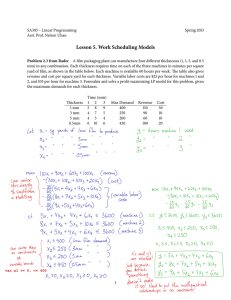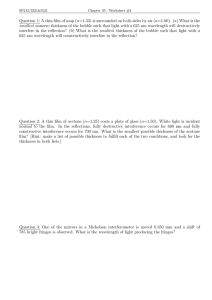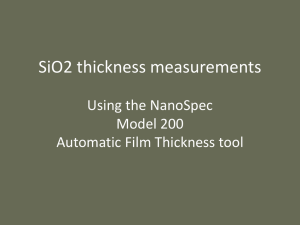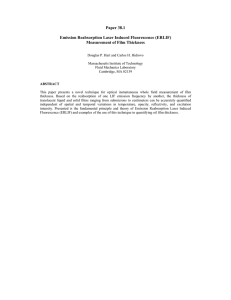FILM THICKNESS STANDARDS ON THE NANOMETER SCALE
advertisement
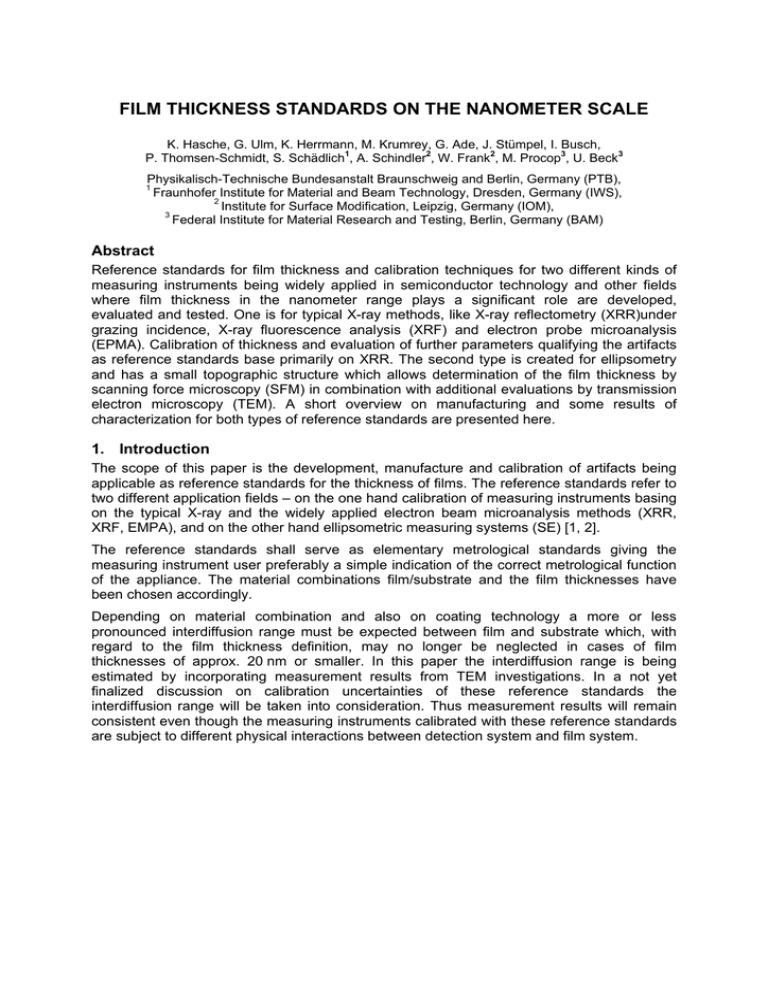
FILM THICKNESS STANDARDS ON THE NANOMETER SCALE K. Hasche, G. Ulm, K. Herrmann, M. Krumrey, G. Ade, J. Stümpel, I. Busch, P. Thomsen-Schmidt, S. Schädlich1, A. Schindler2, W. Frank2, M. Procop3, U. Beck3 Physikalisch-Technische Bundesanstalt Braunschweig and Berlin, Germany (PTB), Fraunhofer Institute for Material and Beam Technology, Dresden, Germany (IWS), 2 Institute for Surface Modification, Leipzig, Germany (IOM), 3 Federal Institute for Material Research and Testing, Berlin, Germany (BAM) 1 Abstract Reference standards for film thickness and calibration techniques for two different kinds of measuring instruments being widely applied in semiconductor technology and other fields where film thickness in the nanometer range plays a significant role are developed, evaluated and tested. One is for typical X-ray methods, like X-ray reflectometry (XRR)under grazing incidence, X-ray fluorescence analysis (XRF) and electron probe microanalysis (EPMA). Calibration of thickness and evaluation of further parameters qualifying the artifacts as reference standards base primarily on XRR. The second type is created for ellipsometry and has a small topographic structure which allows determination of the film thickness by scanning force microscopy (SFM) in combination with additional evaluations by transmission electron microscopy (TEM). A short overview on manufacturing and some results of characterization for both types of reference standards are presented here. 1. Introduction The scope of this paper is the development, manufacture and calibration of artifacts being applicable as reference standards for the thickness of films. The reference standards refer to two different application fields – on the one hand calibration of measuring instruments basing on the typical X-ray and the widely applied electron beam microanalysis methods (XRR, XRF, EMPA), and on the other hand ellipsometric measuring systems (SE) [1, 2]. The reference standards shall serve as elementary metrological standards giving the measuring instrument user preferably a simple indication of the correct metrological function of the appliance. The material combinations film/substrate and the film thicknesses have been chosen accordingly. Depending on material combination and also on coating technology a more or less pronounced interdiffusion range must be expected between film and substrate which, with regard to the film thickness definition, may no longer be neglected in cases of film thicknesses of approx. 20 nm or smaller. In this paper the interdiffusion range is being estimated by incorporating measurement results from TEM investigations. In a not yet finalized discussion on calibration uncertainties of these reference standards the interdiffusion range will be taken into consideration. Thus measurement results will remain consistent even though the measuring instruments calibrated with these reference standards are subject to different physical interactions between detection system and film system. 2. Reference standards for XRR, XRF and EPMA 2.1 General remarks and comments on the manufacture of the artifacts The artifacts consist of fused silica substrate (dimensions: length 60 mm, width 20 mm, height 10 mm). One large surface to be coated has to be smoothed by ion beam polishing to an RMS-value of roughness smaller than 0.3 nm [3]. The reason being the significant influence of roughness and deviation from flatness on the accuracy of the thickness determination by XRR. As coating, a platinum film or a film system of carbon-nickel-carbon with a nominal metal thickness of 10 nm and 50 nm respectively are chosen. The carbon films serve as protection against oxidation of the Nifilm and to reduce interdiffusion of film and substrate. Films are deposited by physical vapor deposition (PVD) technique being well approved in the field of Xray mirror production [4] and adapted for this task. Fig. 1 shows a thickness figure 1: 10 nm Pt-film on a fused silica substrate as thickness standard. standard for X-ray facilities 2.2 Metrological characterization of reference standards for XRR, XRF and EPMA Calibration of film thickness and determination of other parameters (e.g. variation of film thickness over the whole surface) characterising the artifact as reference standard base primarily on XRR. Results found on different facilities during independent investigations show satisfying consistence. Fig. 2 shows the reflectance as function of the grazing incidence angle at a photon energy of 8.048 keV for a C-Ni-C film system with a nominal film thickness of 50 nm Ni as typical XRR measurement data. figure 2: Measured reflectance R as a function of the grazing incidence angle (E = 8.048 keV) Fig. 3 contains the calibration values of the metal films (Ni resp. sample Pt) of 5 artifacts determined from the XRR measurement data incl. POG 2 C – 10 nm Ni - C 9.84 ± 0.15 8.1 the measurement uncertainties established in the measurement POG 8 C – 10 nm Ni - C 10.29 ± 0.15 8.1 process. The thickness of the POG 9 C – 50 nm Ni - C 53.5 ± 0.3 8.9 C-films, not mentioned in this table, is about 2 nm. In the right POG 10 10 nm Pt 19 15.62 ± 0.18 hand column the densities of the POG 4 50 nm Pt 21.4 28.8 ± 0.2 metal films determinable from the measurement data are listed. The results give an impression of the figure 3: Results of film thickness calibration by XRR outstandingly low uncertainty of this method applied at PTB’s beamline at BESSY II [5] and by various facilities of other involved partners. For nanometer films the metrological quality of the surface and interface between film material and substrate are essential and were therefore examined by SFM and TEM. Results arrived at by TEM are reported here. As a test a thin platinum film with a nominal thickness of 10 nm was deposited on an SiO2-wafer (not comparable with smoothed surface) and analysed. The wafer has a thickness of 400 µm and is chosen as substrate to minimise the influence of preparation for the TEM cross section observations. The result of this investigation is documented in fig. 4. The surface of the SiO2-wafer is shown on the left; its roughness is estimated at a value of 0.5 nm. On the right the surface is covered by a Pt-film with a thickness of 12.7 nm ± 0.8 nm. The interface between Pt-film and substrate material is blurred over a width of approx. 0.9 nm. The substrate surface seems to be roughened by the coating process. nominal film system density of thickness metal film 3 value in nm in g/cm figure 4: TEM-investigation of the surface of an SIO2-wafer without a top layer (left) and with a Pt-film (right) The film thickness variations over the whole surface pose another important question which is investigated by XRR and XRF. Fig. 5 shows a map of thickness values over a whole sample measured by XRF at BAM’s beamline at BESSY II. The homogeneity of a film is examined by XRR in a two step procedure. To start with the reflectivity is measured as a function of the angle, and thereafter in a second step the angular value of a minimum in reflectivity is selected and the artifact is moved laterally along one axis. Reflectivity changes during such a scan indicate an inhomogeneous thickness and a second XRR measurement can be done at another position on the scanned line to verify this. As a figure 5: Film thickness variations over the result of such scanning on several whole surface examined by XRF artifacts thickness variations within ± 0.2 nm along the short axis of the artifacts are found. This value agrees with the value of uncertainty of a single XRR measurement at the center of the sample. 3. Reference standards for ellipsometry 3.1 General remarks and comments on the manufacture of the artifacts On Si-wafers with a diameter of 150 mm and (100) surface orientation a film of thermal oxide is grown and subsequently structured by direct electron beam writing. By dry etching with plasma the thickness of the oxide film is reduced to a value of roughly around 100 nm. Wet etching in buffered hydrofluoric acid further reduces the residual oxide. After that the mask is removed and a protective film is deposited for separating the wafer into chips by sawing. Twenty identical chips (resp. artifacts) are located on a wafer. A number on each chip marks their location on the wafer. The chip size is 20 mm x 30 mm; the layout is shown in fig. 6. A frame around the main field with four marks serves as search structure. The main field on the chip can be used for thickness measurement by methods working with a probe beam like ellipsometry (or XRR). Two small frames are placed near the bottom left hand corner on the chip (see fig. 6, top). Within the left frame the chip’s position on the wafer during the manufacturing process is defined by a number, the second frame serves the calibration process of the chip – it contains a search structure and 4 topographic structures, being further illustrated in fig. 6 by the SFM area scan at the bottom right, figure 6: Design of ellipsometry standards with a and a 200 µm wide field for micro topographic structure for calibration by SFM (on the top spot investigations. the chip layout as a whole, bottom left the topographic structure and micro spot field, bottom right the topographic structure) Chips are manufactured with nominal thickness values of 1 µm, 400 nm, 160 nm, 70 nm and 6 nm. 3.2 Metrological characterization of reference standards for ellipsometry As mentioned above each calibration standard can be used for different measurement methods and is not limited to one type of instrument. Par example the scale on the z-axis of an SFM can be referred to XRR measurement results by these standards for the case of the two smallest values of film thickness. Therefore the homogeneity of the thickness over a chip has to be characterized carefully. As a first test a chip from the center and another from the perimeter of a wafer are investigated by TEM. The nominal thickness of the SiO2 film is 6 nm. The chip from the center of a wafer has a measured thickness of about 5.9 nm ± 0.3 nm. The thickness of the film on a chip from the perimeter of the wafer is about 5.9 nm ± 0.5 nm. figure 7: Film thickness evaluation and interface inspection by TEM (the measured thickness values are 5.9 nm ± 0.3 nm and 68.2 nm ±0.9 nm) Fig. 7 shows the image from a TEM evaluation in respect of to the chip with the nominal thickness of 7 nm. Another example refers to an evaluation by TEM on a 70 nm artifact. A thickness of 68.4 nm was found in the center of the chip, and thicknesses of 68.2 nm and 68.5 nm near the bottom left hand corner. The estimated uncertainty was ± 0.4 nm. An adequate homogeneity in film thickness over one wafer is also verified by XRR measurement. For a nominally 70 nm film thickness values of 69.2 nm and 68.9 nm are measured on two chips located at the center of a wafer, and 69.0 nm at the perimeter of the wafer. All these values are measured with an uncertainty of 0.2 nm. Spectral ellipsometry (SE) shows variations of thickness values of 2 % over the whole wafer for the nominal 6 nm artifacts, and less than 0.5 % for the others. thickness thickness value nom. thickness value by sample by SE in nm in nm SFM in nm 1 6 5.8 7.5 2 70 70.2 68.1 3 160 164 163.6 4 400 388 387.5 5 1000 999 1009.7 figure 8: Results of SFM and SE measurements Results of SE (spectroscopic ellipsometer with rotating analyser) and SFM measurements on similar artifacts are stated in fig.8. The relative uncertainty of the SFM results is estimated to be smaller than 1 %, for the 6 nm artifact it is about 1 nm. For a conclusive statement on this measurement uncertainty we have to take into consideration that SFM measurements are insensitive to interdiffusion phenomena. Therefore the force microscopic method must be seen in the context of complementary methods. Furthermore, we try to find comparable measurement results also for methods such as XRR, SE and TEM which are widely used for film thickness measurements in the nm-range. This is the background of current investigations aimed at consistent results based on the application of different methods. The model is still being adapted to achieve consistence with SFM results. The results of the SE measurement depend on the model. The estimated uncertainty is 1 nm + 0.01 x d, d = film thickness. 4. Conclusions Two different kinds of film thickness standards are fabricated and characterized by several techniques of film thickness measurement. Calibration results for the X-ray methods’ standards are consistent on an expanded uncertainty level below one nanometer. The standards for film thickness determination by ellipsometry have been fabricated and some results are reported. These results show that consistence should be reachable on a relative standard uncertainty level below 1 % if the smallest film is excluded. The involvement of complementary evaluation methods like XRR, XRF, SE, TEM and SFM seems to be a promising way in case of films in the nanometer range. The full characterization of both types of standards has not yet been finalized. 5. Acknowledgement This work is financially supported by BMBF via project no. 13N 7704 “Calibrated reference standards of coating thickness in the nanometre range”. Particular thanks to Mr. D. Hirsch, IOM, Mrs. M. Männ, BAM, and Dr. Min Xu, PTB, for valuable evaluations. 6. [1] [2] [3] [4] [5] References K. Hasche, K. Herrmann, M. Krumrey, G. Ulm, S. Schädlich, W. Frank, M. Procop Proc. euspen International Conference 2001, Turin, Italy, 2001, pp. 396-399 K. Hasche, K. Herrmann, M. Krumrey, G. Ulm, G. Ade, P. Thomsen-Schmidt, S. Schädlich, W. Frank, M. Procop, U. Beck: PTB-Report F-44; Proc. 5th Seminar on Quantitative Microscopy, Bergisch-Gladbach, Germany, 2001, pp. 13-21 R. Fechner, A. Schindler, T. Hänsel, F. Bigl, Proc. 9th ICPE, Osaka, 1999, pp. 249-254 R. Dietsch, T. Holz, T. Mai, C.-F. Meyer, R. Scholz, B. Wehner: Applied Surface Science 127-129 (1998) pp. 451-456 M. Krumrey and G. Ulm, Nucl. Istzr. Meth. A 467-468 (2001) pp. 1175-1178
